Reviving Arts to Promote Self-Expressions in English Language Classroom
Sirhajwan Idek graduated with bachelor’s degree, master’s degree and doctor of philosophy from UiTM, Shah Alam, Malaysia. He has been teaching at Keningau Vocational College since 2012. He, along with his colleagues, started the project Dau Dau which guides students to create their own artistic work that can be in the form of performance, visual or literary work that portrays their ethnic culture, personal concern, or their thoughts on contemporary issues. This project has won the 2021 Simon Greenall Award and was a finalist for ELTons Innovation Awards in the local innovation category in 2022. Sirhajwan was also the first Malaysian to win SEAMEO-Australia Education Link Award in 2018 with his project “Think Tale” in which he used ethnic stories to teach English language. He is the head of research and innovation at the school in which his responsibility is to guide and assist the students and teachers in developing their solutions to problems related to schools and the community. His students have achieved various recognition with their work either in arts or innovation. Email: sirhaj87@gmail.com
Introduction
School students’ lack of mastery of English language remained a persistent problem in Malaysian education landscape. It is likely that the absence of English-speaking environment coupled with the embedded misconception that majority of the population has on the language led to the stagnancy in the progress of the English language education in the country. In order to bridge the gap between the students’ backgrounds with English language, it is likely that the incorporation of integrated arts in English language learning can encourage students to reconcile their self-identification with the perceived nature of the target language.
Self-Identification and language learning
Students’ self-identification is heavily influenced by the culture of the community that they have grown accustomed with. According to Lev Vygotsky, children learn by internalizing the activities, habits, vocabulary and ideas of the members of the community in which they grow up (Vosniadou 2001, p. 9). Weedon (1987) explained that our sense of ourselves, our subjectivity or in other word known as identity is constructed through the language that underlies the social organization that we live in. This signifies the role of the native language, along with the culture that it is associated with, in determining our styles in acquiring a new body of knowledge like a foreign language. Peirce (1995, p. 13) stated that Second Language Acquisition (SLA) must take into account that language leaners have complex social identities within a context of a large social structures which are reproduced in day-to-day social interaction. Any attempt to meet such need often results in a narrow view of identity (Firth & Wagner 1997). Hence, Anwaruddin (2012) argued that SLA does not sufficiently focus on the different identities of the learners since this must be considered as their learning needs too. In a country of diverse cultures especially in Sabah where there are dozens of ethnicities and native languages, it is important to acknowledge that every learner in the English language classroom has their own sociocultural identities which may influence their perception on English language and subsequently, their acquisition of the language. Therefore, English language learning must help these students to reconciliate their identities with English language that encourages them to express themselves in the target language.
Narratives in Language Learning
Anwaruddin (2012) explained that personal narratives can help to bridge the gap between personal experience and social structure. Weiner (2011) claimed that there is an interaction between individual lives, perceptions and experiences and the educational setting in which individuals live and work and they constantly negotiate their identities in reference to social and cultural norms and expectations. Anwaruddin (2011) deduced from her findings on students’ autobiographical writings that they construct and change their identities as they go through the learning process of the English language. This indicated that learners’ second language acquisition is linked with their identity formation.
Problem statement
Majority of students in Sabah and across this nation are aware of the importance of English language and English language education starts as early as kindergarten and it is taught throughout primary and secondary education as a core subject that everyone must take. Despite the implementation of such curriculum for decades and the status of the language as the nation’s second language, most Malaysians are not fluent in English language. In fact, school students generally have difficulties in learning and using it proficiently.
The complexity of the factors affecting students’ inability to master the language can be hard to dissect but one contributing factor is students’ attitude and perception on English language as a foreign language that is associated with elitism and social class that they don’t see themselves fit into. As the students conceptualize the language as a form of cultural capital they can never afford, it creates a sense of inferiority and lower self-efficacy for them to acquire the language. Since Sabah is a home to diverse ethnic groups with their respective native languages, it creates a wider gap between how the students identify themselves socially and how they perceive English language. The situation is a huge contrast to Malay language, the country’s national language that is widely spoken, which has been successfully introduced in school education since the formation of Malaysia. Although most Sabahans identify with their native ethnicities, they are able to learn and speak Malay language well which can be easily attributed to the role of the language as Lingua France in the region for centuries and its similarities with other native languages. However, English language remains as a language that most lack the inclination to learn and use.
Another rising concern that cannot be dismissed is how the community might see English language as a threat to their mother tongues and native cultures. Although the significance of English language is well-understood and generally acknowledged by many, some fear that the expanding integration of English language into our personal and professional life contributes to the erosion of local cultures and disappearance of native languages. Since learning a language involves learning the culture that it originates from, as English language gains more influence in the society, the culture of English-speaking nation will slowly seep into our daily conversations and traditions, replacing our own local words and in a larger context, ethnic customs and social practices.
In fact, the strong presence of European fairytales and pop cultures of English-speaking countries in our society has reverberated across generations for decades through our preferences for entertainment and fictions that derived from these foreign nations over ours. English fairytales have become more popular than our local folklore as evidenced by children’s knowledge of stories like Snow White and Rapunzel than as well as teen obsession on American and British music, movies, TV shows and social trends. Other than this, the increasing usage of Malay language among the local population has resulted in the gradual replacement of original vocabulary in the different native languages with Malay words and phrases. This is another rising concern since if there is no effort in conserving the native languages via real-life communication, there will be permanent loss of native vocabulary.
Pedagogical Intervention based on arts and folklore
The potential of performing arts in language education is evident through the use of active movements, emotional expressions and sensory experience to bring meanings to semantic aspects of language. Barsalou (2008) associated language learning with grounded cognition which recognizes that semantic memory is linked to perception, action, and/or introspection in which motor simulation (movement), affective simulation (emotion or expression), and gesture are the basis of cognitive process of language comprehension. This was corroborated by Glenberg (2010) who stated sensory, action and emotion systems of our bodies serve as the ground for learning where words and phrases become meaningful through our interactions and experiences that involve these systems. He further added that sentences are understood by simulating the content through neutral systems commonly used for perception, action and emotion as these are integral to language development. Oral language conveys messages effectively through emotional information expressed in tone, prosody, facial expression and full-body gestures (Glenberg, 2011).
Think Tales & Dau Dau
The initiatives of reviving arts and folklore to kindle students’ interest to embrace their ethnic and cultural origins and backgrounds started with a project that guided them to research, read, write and perform cultural tales. The project known as “Think Tales” drew students’ attention to legends, myths and fairytales associated with the native races in Sabah, Malaysia, before gradually expanding the theme to include present day stories linked to cultural identities.
As the initiatives evolved to suit the students’ interest, needs and talents, a project named “Dau Dau” which tapped into students’ artistic talents and creative expressions was launched. This is a natural progression from the earlier phase of the effort to kindle students’ curiosity on cultural tales through story writing and storytelling. Dau Dau combines performing arts, literary arts and visual arts to enrich students’ learning experience by helping and mentoring them in producing their own artistic works with folklore as the primary theme. The secondary theme was personal and social issues. In guiding and assisting the students to produce their artistic work, there is a basic procedure that they will actively participate as the director, writer and performers.
- Deciding on the art forms: integrated arts involve many forms, styles and genres. Performing arts encompass multiple types of performances that may include theatre, radio play, pantomime, poetry, storytelling, puppetry, animation and monologue. Literary and visual arts might largely differ than performing arts with their own specific criteria.
- Determining the premise: There is always a plot, a narrative, a theme, a subject matter or a message that an artistic work revolve around. This is how the content and the performance of the artistic work develops from.
- Selecting the setting: there must be a specific event that occurs at a specific period at a specific place. Thus, the story can take place centuries ago or in the present day. It can happen in an alternative universe too.
- Creating the characters: this process often starts with the protagonists and certain traits such as personalities, physical appearances and backgrounds are essential in creating characters that are dynamic and relatable. Character development is also part of the process.
- Splitting the scenes: a storyline can consist several scenes and visualizing the different scenes can help to illustrate the progress of the performance via different scenes that depict different stages of story development.
- Writing the script: The script must be written according to the chosen art forms since the art forms heavily influence the format of the scripts. For example, a pantomime contains no oral dialogue and focuses more on movements while a radio play emphasizes sound effects more. Most scripts contain narration and dialogue exchange.
- Practice, preparation, performance (live, recorded): The scripts must be rehearsed to train the performers on voice modulation, intonation, facial expression, movements and pronunciation. The performance can be prerecorded or presented live.
Scriptwriting
The script is done collaboratively with the equal participation of students. The script will be drafted and revised in accordance with the specific type of narrative performance that the students choose to deliver.
|
Type of performance |
Format |
Example |
|
Theatre & drama |
The script is considered the most standard script that contains dialogue and minimal narration. |
Nina: (tiptoeing up a staircase) It is so dark in here.
A spider jumped on Nina’s shoulder
Lola: (squealing) Nina, your shoulder!
|
|
Reader’s theatre |
Since reader’s theatre requires the actors to read the script with minimal acting that is often done through gestures and facial expression. The script contains continuous script reading with regular narrations. |
Narrator: Sheila was on the phone when she heard a knocking on the door.
Sheila: Wait a minute! Timmy: (firm) Don’t open it!
|
|
Pantomime |
Pantomime is a type of play with no oral speech or sound from the actors. There is no verbal dialogue. Hence, the emphasis is on facial expression, movements and gestures. The vocabulary used in the pantomime script must be carefully selected so the script portrays more actions. |
He knocked the door open and he was shocked to see what’s inside. He quickly ran to the kitchen and opened the cupboard and took out a large knife. |
|
Radio play |
Radio play is a form of play that is fully performed via spoken dialogue, sound effects and music. It has no visual. Hence, the actors must fully use their voice acting skills to bring the script alive. The script must contain sound-oriented vocabulary that can be produced live or via edited recording. |
Cars are passing by the street and footsteps of people can be heard.
Tina: (Ring the bell) I would like to order two cups of coffee please?
Warren: Would you like the coffee with sugar? (Pouring coffee into a cup)
Tina: (Hesitating) Hmmm. Just a small amount of it.
|
|
Puppetry |
There are many types of puppet shows which encompass stick puppets, hand puppets, string puppets, shadow puppets and ventriloquism. Since puppet show is performed by moving the puppets and providing voices to these characters, the script must portray movements that can be made via specific moveable parts of the puppets like their arms and their mouths. Most puppets cannot move their lower limbs since these are where the puppeteers hold and control the puppets.
|
Lion: I will find you and once I do, I will eat you.
Narrator: The little mouse feels so scared but it knows that it will feel safe hiding underneath the rock.
Mouse: (Stuttering) You don’t want to eat me. I have very little meat.
|
|
Animation |
Animation relies on illustrations that are drawn to portray the story. Hence, the script is split according to the number of scenes which are represented by illustrations that depict a certain action, situation, place or event. It might contain several narrative paragraphs that explain each scene. |
On the next day, Kiki was picking wild berries when he suddenly heard a strange sound coming from the mountain.
He immediately jumped on his horse and went to the mountain. Little did he know that he was being followed by a group of knights.
|
Themes
Since narrative writing plays an essential part in bridging the students’ identities with the target language, the primary theme is cultural stories that revolve around folktales, legends, myths, fairytales, historical events and present-day stories that incorporate cultural elements such as artefacts and languages. The secondary theme is social and personal issues since some students might want to focus on societal problems as well as personal experiences.
Classroom strategies
There are several strategies on how to boost students’ self-expression and performance skills. Students should be taught to practice their voice modulation that includes pace, tone, emphasis, pitch, volume as well as articulation in delivering lines. They also need to pronounce words accurately.
Script reading
Script reading can be done virtually or in physical classroom. The students are assigned with different roles in the script and they take turn in reading their parts while putting up acting performances. This activity also trains the students to interact with each other via dialogue embedded in their script. It also helps them to connect with the target audience.
Monologue
Students can be assigned with individual monologues in which they must gain in-depth understanding of the character that this monologue belongs to in order for them to be able to portray the role well. Monologue helps students to better empathize with the characters that they play in order to exude the emotions that the characters experience. This helps the students to delve deeper into the character’s history, emotional states, thoughts and the context that this character derives from.
Card stories
Card stories is an activity that can familiarize students with story writing and storytelling. Students are given a set of cards containing pictures and they can pick a random number of cards and put these cards in a sequence to create a story. They can use their own devices to create a video of their voices narrating the story while moving the camera across the cards to capture the illustrative narrative.
There are other activities that can be done in the classroom to help students become accustomed with narrative performing arts such as chain story, freeze frame and charade. Role-play is another common activity that assist students to create a situation involving several characters for them to act out.
Outcomes
While the script reading and impromptu performance were regularly done in the classroom, the extension of this project went beyond classroom in which the students wrote their own scripts, staged their own performances and recorded them. The students were given the autonomy to decide on what type of performance, genre and storyline that they would like to do. These were some of the of students’ works that were rehearsed and recorded.
Readers’ theatre
Readers’ theatre is a type of theatre that has minimal or no props, scenery and costumes. The actors present dramatic readings of a narrative text and this is often aided by the use of music stands and stools.
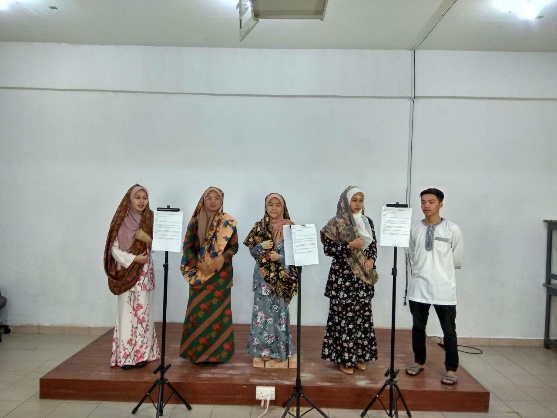
The students adapted an existing text to deliver a folktale about a paddy spirit. During the adaptation of the text into a workable script, the students changed many of the indirect speeches in the text into direct speeches to create more dialogue that could be delivered by the actors to make the performance livelier and more dynamic.
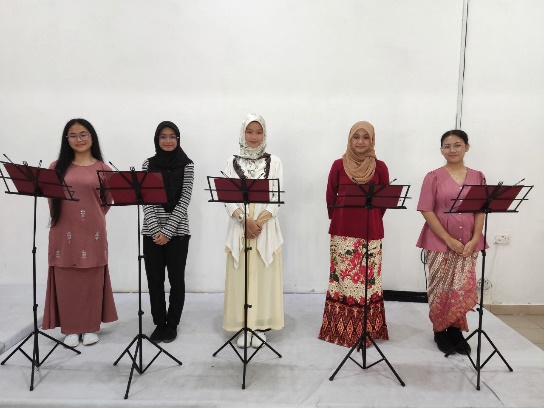
These students wrote their script collaboratively. They chose present day plotline that revolved around the different phases of growing up from school teenagers to working parents. They initially chose to do horror comedy but they changed their mind halfway through the script since it didn’t have any strong message or storyline and it required longer text that would lead to longer performance time. They previously agreed on a shorter performance.
Puppetry
Puppet show is a type of performance that involves inanimate objects, often resembling humans or animals, being manipulated and voiced to deliver a narrative. The objects are known as puppets and individuals who control these puppeteers. There are many types of puppets which include sock puppets, hand puppets, string puppets, stick puppets, shadow puppets and ventriloquist puppets.
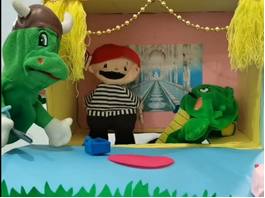
The students who did this puppet show adapted a folktale they found from a book at a local library. It was an origin story of predatory crocodiles and the story was believed to have happened in Papar, a district in Sabah. They simplified the plot in order to keep the duration of the puppet show shorter and they converted many parts of the text into dialogues. Due to the nature of the story, they built two stages for the puppet show to portray the transition within the story as well as the conflict that occurred it in.
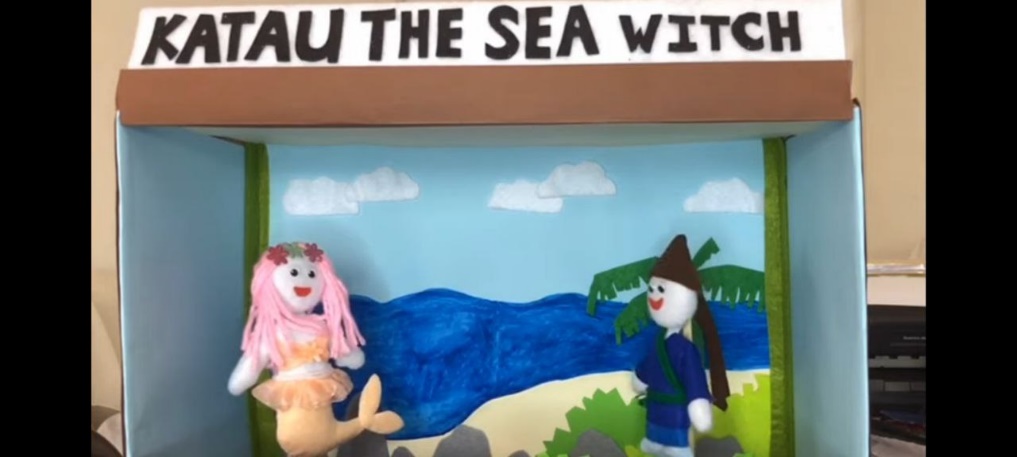
These students were assigned with a script about a man who discovered that the so-called sea witch was just an innocent magical creature being held in captive and was earnestly begging sailors to free her. The students chose a seashore as the background for the stage to portray the two places where this story took place, the land and the waters. The script contained a song lyric that the sea witch sang and the students created a melody for that lyric and sang that part in the recorded performance. They chose to use stick puppets for the performance.
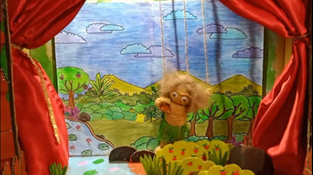
The team had been assigned with a story on a giant that bullied other animals in the jungle until he was punished by the forest spirit. The story which took place in several places mainly near a hill, a river and a huge rock was portrayed through a setting that incorporated these elements. The students created string puppets for the show.
Pantomime
Pantomime is a dramatic performance of a story that is conveyed through facial expressions, hand gestures and bodily movements by the actors without oral dialogue.
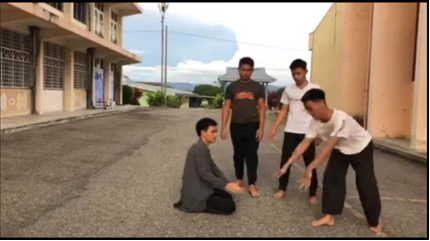
The team wrote the script collaboratively which detailed a brief performance of how a group of bullies coerced their peer into washing their clothes and subsequently paid the price for doing so. The script had no dialogue and the emphasis was on selecting expressions and actions that could be physically conveyed through facial and bodily movements.
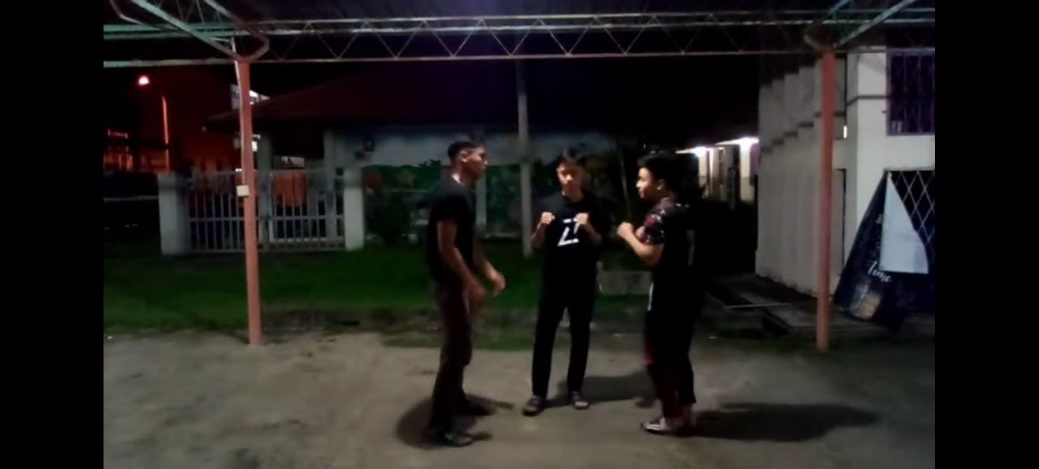
The script was done collaboratively in which the setting of the story was a boxing ring. The team wanted to make it look like a parody with the constant use of memes, sound effects and comic effects that were edited into the video. It was meant to be a boxing match with an unexpected ending.
Radio Play
Radio play is a theatrical performance that is purely auditory in which it has no visual aspect. Radio play relies solely on voices, sound effects and music that can be edited into the performance.

This radio play was written and performed collaboratively by the team. It took place between workers at a restaurant who was trying to figure out whether they accidentally ate an ornamental fish from the restaurant’s aquarium. The script was incorporated with sound effects from daily routine and chores such as dishwashing, drink pouring and phone ringtone.

The team wrote the script to describe a child’s perspective of Christmas where she felt reluctant to part with her doll as her mother insisted that she was too old to have a doll and she needed to make real friends. The play comprised a Christmas jingle and sounds that humans make when they are doing certain activities like eating cookies or in specific conditions such as sobbing.
Animated tale
Animated tale is a form of performance portrayed through a series of illustrations that depict different scenes. The actors or narrators provide their voices to the narrative scenes.
The script was written by a student who also narrated the story. He adapted his story from a myth that linked the land of Borneo now known as Sabah (Malaysia) with the Chinese empire. The script was split into several scenes to allow the illustrator to draw a specific visual artwork for each of the scenes.
Folklore VS Contemporary Issues
It was revealed from the process that the students generally chose personal or social issues as the theme of their narrative instead of arts if they were given full autonomy to decide. This could be attributed to their lack of knowledge or interest in their cultural identities which caused them to opt for what they were most familiar with. However, if they were given specific instruction or were heavily encouraged to develop a story based on ethnic cultures and folklore, it was likely that they would do so. They could either be given materials for them to read and adapt or they could do their own research in libraries or browsing through websites to search for materials. It was evident that they students delved more into reading existing materials to understand ethnic stories better and learn more about traditional cultures when they chose to develop their narratives based on folklore. However, they barely referred to any materials when they chose to write their narratives based on their personal issues or present-day social issues.
Learning gain
As a result of this project, there are several aspects of language learning that the students were able to experience and acquire. This learning process started from the brainstorming process followed by the writing process and then the practice prior to the actual performance. The performance could be either live or prerecorded but recorded videos for the production was regarded as necessary.
- Reading strategies: the activity encouraged students to research on stories by reading books and blogs to gain ideas or to adapt stories that they would like to narrate in their performances. The students learnt to summarize stories, visualize the narratives, extract necessary details like places, time and characters and make connection between the stories with the real life since they need to deliver important messages to the audience.
- Vocabulary: the students task enabled the students to understand specific use of certain words, phrases and idioms and the contexts that they are used in. In order to deliver an effective performance, they must utter their lines with proper emphasis and understanding the text helped them to do so.
- Pronunciation: this activity required the students to pronounce each word clearly and accurately. They were well aware of the importance of pronunciation in delivering their narrations. Hence, they regularly rehearsed on their pronunciations prior to the performance.
- Voice modulation: Acting requires the adjustment and control of voice and tone to communicate messages more effectively. Hence, the students learn to modulate their voices. Depending on the meaning of the lines and the contexts, they must speak louder or softer, faster or slow, dramatic or emotional and with emphasis on certain parts of their lines. The students rehearsed on their parts repeatedly in order to improve their voice modulation.
- Writing process: The students were actively involved in the writing process of the scripts that were used in the performance. This process consisted of brainstorming/prewriting, drafting, revising, editing and performing (substituting publishing).
- Grammar: The students also learnt about certain aspects of grammar in the process such as the use of past tense in writing the narrator’s part while present tense is used in the dialogue. The students also learnt how to convert indirect speech to direct speech when editing and adapting a text.
Implication
This project celebrated diversity and inclusivity since it acknowledged students’ self-expression and cultural identities by guiding them in writing their own narratives and performed these narratives through proper means. It has successfully shown that students are artists, writers and performers in some ways and they have their own stories that they would like to tell either through a written work, a visual artwork, a performance or a combination of any. Teachers should create an environment where these stories can be shared in order to help the students feel accepted and for them to learn to respect each other. Hence, arts should be incorporated into our classroom teaching as well as extracurricular activities to enable students to explore their artistic talents and imagination when learning the English language.
References
Glenberg , A.M. ( 2010 ). Embodiment as a unifying perspective for psychology . Wiley Interdisciplinary Reviews: Cognitive Science, 1 ( 4 ), 586 – 596 . doi: 10.1002/wcs.55
Barsalou , L.W. ( 2008 ). Grounded cognition . Annual Review of Psychology , 59 , 617 – 645 . doi: 10.1146/annurev.psych.59.103006.093639
Anwaruddin, S. M. (2012). Learner Identity in Second Language Education. 3L: The Southeast Asian Journal of English Language Studies. 18(2): 13 – 23
Vosniadou, S. (2001). How children learn. International Academy of Education, Brussels.
Weedon, C. (1987). Feminist practice and poststructuralist theory. London: Blackwell.
Peirce, B. N. (1995). Social identity, investment, and language learning. TESOL Quarterly. 29(1), 9-31.
Firth, A., & Wagner, J. (1997). On discourse, communication, and (some) fundamental concepts in SLA Research. Modern Language Journal. 81, 285-300.
Weiner, G. (2011a). Introduction: What is auto/biography? In L. F. Townsend & G. Weiner (Eds.). Deconstructing and reconstructing lives: Auto/biography in educational setting (pp. 1-19). London, Canada: The Althouse Press.
Please check the Pilgrims f2f courses at Pilgrims website.
Please check the Pilgrims online courses at Pilgrims website.
An Online School Magazine in English
Valentina Batagelj, SloveniaExploring English Teacher’s Perspectives on the Relevance of Teaching Entrepreneurship in Freshman Year
Rasha Osman Abd el Haliem, EgyptReviving Arts to Promote Self-Expressions in English Language Classroom
Sirhajwan Idek, Malaysia